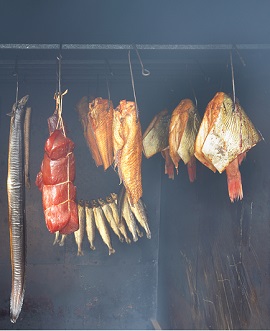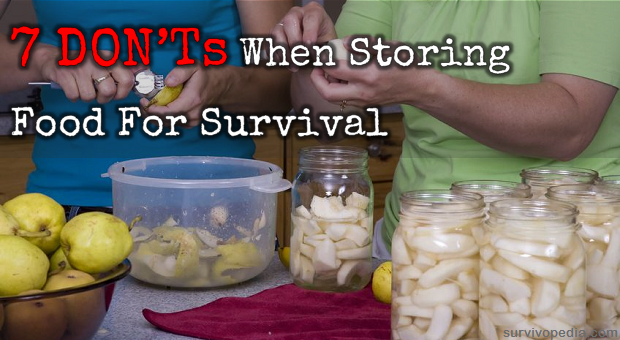There are many articles out there that provide valuable information to people who want to start storing food for survival. However, they focus mostly on what you SHOULD do to start stockpiling and how to store the food once you acquire it.
Today we’d like to focus on some things that you SHOULDN’T do. Some tips are to keep your food from spoiling and others are to keep your food supplies safe. All are things that you consider.
Let’s get started!
1. Don’t Tell Anybody You’re Stockpiling Food
Though many of us have a need to share information with those that we care about, our well-intentioned advice to the neighbor could be exactly what sinks the ship when SHTF.
If you tell people that you have stores of food, it’s a sure bet that they’ll come knocking (or shooting) when they’re starving because they didn’t have the same foresight that you did.
Encouraging people to be prepared is a good thing but do it in vague terms that don’t reveal exactly what you’re doing. Put out feelers by asking if they’ve considered what they would do in case of emergency.
If you get a positive response, you may wish to discuss generalities but don’t share the fact that you’ve already stockpiled 6 months’ worth of food for yourself and your family. It makes you a target.
2. Don’t Store Dry Goods in Their Original Containers
Though cardboard boxes and plastic bags stack easily and fit nicely on shelves, they’re vulnerable to pests, rodents and weather. If you’re storing pasta, rice, flour or other dried goods, do so in air-tight containers that critters or humidity can’t permeate.
Even though it’s relatively inexpensive when you consider the cost per box, it’s wasted money if the food is eaten by rats, infested with bugs or ruined by weather.
Plastic containers with lids are readily available at just about any yard sale that you visit. If you want new ones, they’re extremely inexpensive at places like Wal-Mart or the dollar store.
There’s no need to waste your time stockpiling food if you’re just going to end up throwing it away or feeding it to the rats!
3. Don’t Forget to Rotate Your Supplies
Though canned goods are often good for 10 years or more, they do begin to lose flavor and nutritional value as time goes by.
Operate your supplies on a FIFO basis – first in, first out. This means that you use the old food and store the new food.
The easiest way that we’ve found to do this is to simply store the new food behind the old so that when you reach for a can of green beans, the oldest one is in front.
This keeps your stockpile fresh and ensures that nothing is going out-of-date.
4. Don’t Buy Food You Don’t Eat
Though canned lima beans may be on sale at 5 cans for $1, they’re on sale for a reason – most people don’t eat them on a regular basis! They may be nutritious but if you don’t eat them now, you probably won’t want to eat them later, either.
The easiest way to stick to this is to simply pick up an extra can of corn when you’re already buying a can or two for dinner that night. That way, what you buy for your stockpile corresponds with what you’re already eating.
If you notice items in your stockpile that have been there for a while, don’t buy any more of that food.
5. Don’t Concentrate on Buying Freezer Foods
 Yes, it’s wonderful to have a freezer stocked with meat but don’t forget that if the power goes out and you don’t have back-up electric, all of that meat will be bad within about a week.
Yes, it’s wonderful to have a freezer stocked with meat but don’t forget that if the power goes out and you don’t have back-up electric, all of that meat will be bad within about a week.
Also, frozen meats only survive for about six months before they start getting freezer burn and tasting weird.
If you want to store meat long-term (and you should!) consider other preservation methods such as canning or dehydrating. Canned meat can last for up to 10 years and dehydrated meat is good for a couple of years as long as it stays dry.
Preserve your own meat instead of paying somebody to do it – that way, you’ll have the experience necessary for when SHTF in real time.
6. Don’t Skip Steps when Preserving Food
Canning and dehydrating can be arduous tasks. The success of the process depends highly on how well you follow each and every step.
Skipping the heating process won’t kill the bacteria in the food and jars and your food will spoil. If you don’t get the rims of the jars clean after filling them, the lids won’t seal and your food won’t be properly preserved. If you don’t dry your meat or produce enough or you don’t trim all the excess fat off, your dehydrated food will quickly mold or go rancid.
Food preservation techniques have steps for a reason. Follow them to avoid wasting food and time.
7. Don’t Store an Imbalanced Supply of Food
Your body requires nutrients that are supplied from a wide array of foods. Red, green, yellow and orange produce have different nutritional profiles. Meat and beans have protein. When you’re building your stockpile, don’t forget to include a variety of food that meets the dietary needs of your family.
Another reason for this is that there are instances where people were surrounded by food, namely rice, and they starved to death due to food fatigue. This happens when your body consumes so much of a single food that it simply can’t stand to eat another bite of it. Varying your food stores will eliminate the risk of food fatigue.
Though stockpiling food is a fairly simple process, you do need to put some thought into it. Make sure that when you’re planning your list, you take dietary needs such as food allergies into consideration.
Also, do an analysis of how much food you’ll need per day, per person so that you don’t come up short should SHTF. In this case, it’s always better to have too much than not enough.
We hope that this list helped get you thinking about what NOT to do when storing food for survival. If you have any other tips or suggestions, please share them with us in the comments section below!
This article has been written by Theresa Crouse for Survivopedia.
22 total views, 22 views today
[Total: 0 Average: 0/5]
Source:: Survivopedia




